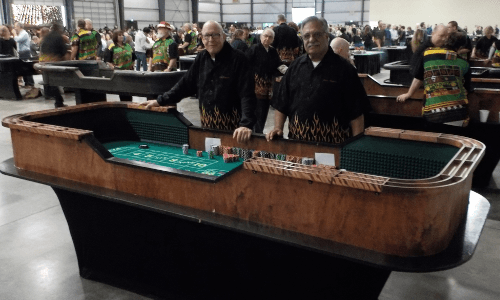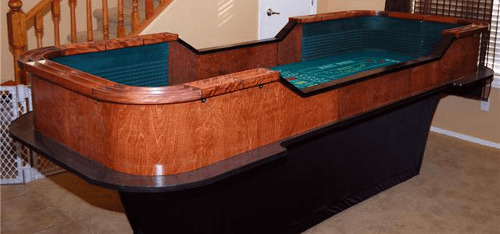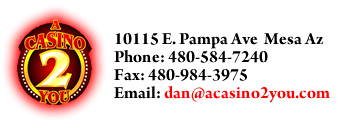Craps
A Casino 2 You Provides ....
Genuine, casino-sized, tables featuring chip rails, four-color deep-dyed casino layouts, pyramid rubber. Accessories include: dice, stick, on/off puck, gaming chips and 2 / 3 professional dealers.
As a casino enthusiast, you know how crucial it is to have variety and a taste for the unpredictable in your playing experience. No other game perfectly captures these attributes better than Craps. However, the adventure doesn’t have to stop there. At our affiliated site, plinko-aztec.com, they offer the exciting Plinko game, which is a stimulating reprieve from the intensity of Craps, allowing players to unwind without giving up the possibility of winning big prizes! Don’t miss an opportunity to take your casino experience to a whole new level and add an Aztec twist to your gaming!
Cost of Craps Services
Prices are for 3 hours. The price includes table, dealer(s), chips, dice, stick, pucks, raffle tickets, players club cards and FUN.
Craps - $330 / 8 foot Craps table with 2 dealers - $440 / 10 foot Craps table with 3 dealers
 Delivery, set up and break down fee --Additional
Delivery, set up and break down fee --Additional
A 25% deposit and signed contract is required to book date of party. The remainder is due, the night of the party, prior to beginning.
Friday & Saturday dates in December require an additional 10% up-charge.
The Game
With dice flying and players cheering every roll, Craps is usually known as the most exciting game in a casino. Place your bets for or against the shooter. Craps can be intimidating to new players, so what better place to learn than alongside the comfort of our courteous, professional staff.
"" Craps is a dice game played by multiple or a single player betting against the bank on the outcome of the roll, or a series of rolls, of a pair of dice. The players and dealers stand or sit around a large oval "craps table."
The craps table
In a casino, players make bets with chips on a specially made craps table with a "layout" – a table cloth made of felt that displays the various betting possibilities, which vary somewhat in bet presence, position, and payout among casinos. The tables have the shape of a bathtub, about 10' to 14' long, 5' wide, about 28" above the floor at the bottom, where the layout is, and about 2' from the layout up to the rim of the tub.
With the table oriented with its long sides running left to right, along one long side is the casino's bank – thousands of chips, stacked 20 high, standing on the layout. Along the opposite side of the tub is usually a long, angled mirror. The left and right U-shaped sections of the table each have the same bet areas marked on the layout, with space for usually up to 8 players to stand and place their bets on each side. The walls of the tub around these sections are usually covered with a rubberized pyramid-shaped texture, used to randomly reflect the dice that are thrown towards them from the opposite side of the table.
 An additional group of bets is in the middle of the layout, are referred to as proposition bets, and are used for bets by players from both sides. The top rim of the table has horizontal grooves for players to keep their chips (lying horizontally) while not in play.
An additional group of bets is in the middle of the layout, are referred to as proposition bets, and are used for bets by players from both sides. The top rim of the table has horizontal grooves for players to keep their chips (lying horizontally) while not in play.
The dealers
The table is run by up to four dealers: a boxman, seated behind the casino's bank, who manages the chips, supervises the dealers, and handles "coloring up" players (exchanging small chip denominations for larger denominations in order to preserve the chips at a table); two base dealers who stand to either side of the boxman and collect and pay bets to players around their half of the table; and a stickman who stands directly across the table from the boxman, takes and pays (or directs the base dealers to do so) the bets in the center of the table, announces the results of each roll (usually with a distinctive patter), moves the dice across the layout with an elongated wooden stick. Each dealer also watches for mistakes by the others because of the sometimes large number of bets and frantic pace of the game.
Rules of play
Each casino may set which bets are offered and different payouts for them, though a core set of bets and payouts is typical. Players take turns rolling two dice and whoever is throwing the dice is called the "shooter". Players can bet on the various options by placing chips directly on the appropriately-marked sections of the layout, or asking the base dealer or stickman to do so, depending on which bet is being made.
 While acting as the shooter, a player must have a bet on the "Pass" line or the "Don't Pass" line. "Pass" and "don’t pass" are sometimes called "Win" and "Don’t Win" or "Right" and "Wrong" bets. The game is played in rounds and these "Pass" and "Don't Pass" bets are betting on the outcome of a round. The shooter is presented with multiple dice (typically five) by the "stickman", and must choose two for the round. The remaining dice are returned to the stickman's bowl and are not used.
While acting as the shooter, a player must have a bet on the "Pass" line or the "Don't Pass" line. "Pass" and "don’t pass" are sometimes called "Win" and "Don’t Win" or "Right" and "Wrong" bets. The game is played in rounds and these "Pass" and "Don't Pass" bets are betting on the outcome of a round. The shooter is presented with multiple dice (typically five) by the "stickman", and must choose two for the round. The remaining dice are returned to the stickman's bowl and are not used.
Each round has two phases: "come-out" and "point". To start a round, the shooter makes one or more "come-out" rolls. A come-out roll of 2, 3 or 12 is called "craps" or "crapping out", and anyone betting the Pass line loses. A come-out roll of 7 or 11 is a "natural", and the Pass line wins. The other possible numbers are the point numbers: 4, 5, 6, 8, 9, and 10. If the shooter rolls one of these numbers on the come-out roll, this establishes the "point" - to "pass" or "win", the point number must be rolled again before a seven. The dealer flips a button to the "On" side and moves it to the point number signifying the second phase of the round. If the shooter "hits" the point value again (any value of the dice that sum to the point will do; the shooter doesn't have to exactly repeat the value combination of the come-out roll) before rolling a seven, the Pass line wins and a new round starts. If the shooter rolls any seven before repeating the point number (a "seven-out"), the Pass line loses and the dice pass clockwise to the next new shooter for the next round. In all the above scenarios, whenever the Pass line wins, the Don't Pass line loses, and vice versa, with one exception: on the come-out roll, a roll of 12 will cause Pass Line bets to lose, but Don't Pass bets are pushed (or "barred"), neither winning nor losing. (The same applies to "Come" and "Don't Come" bets.) "" -- Wikipedia















